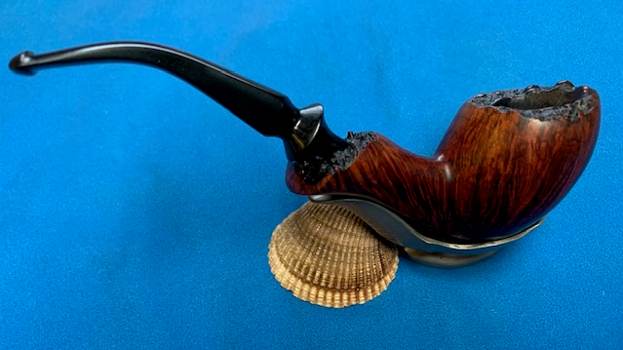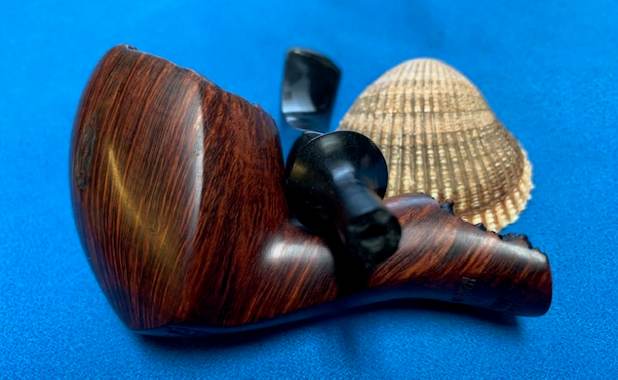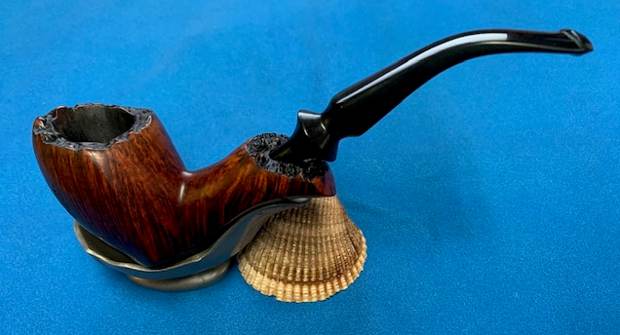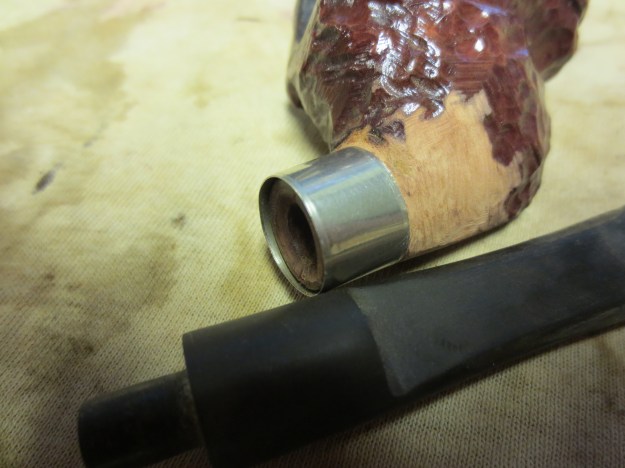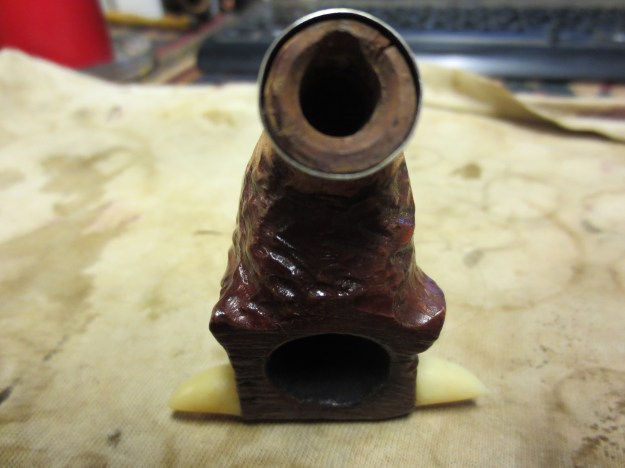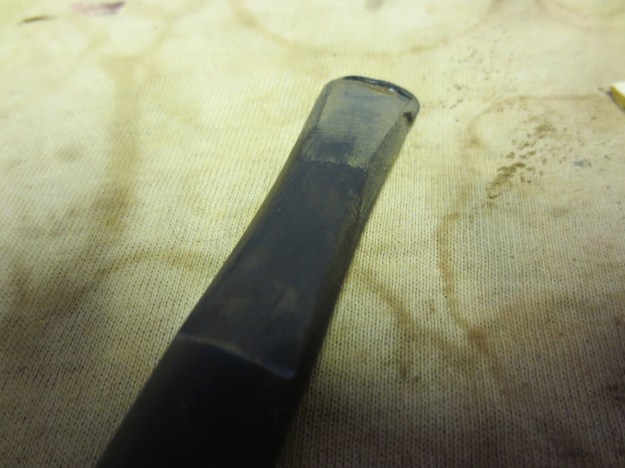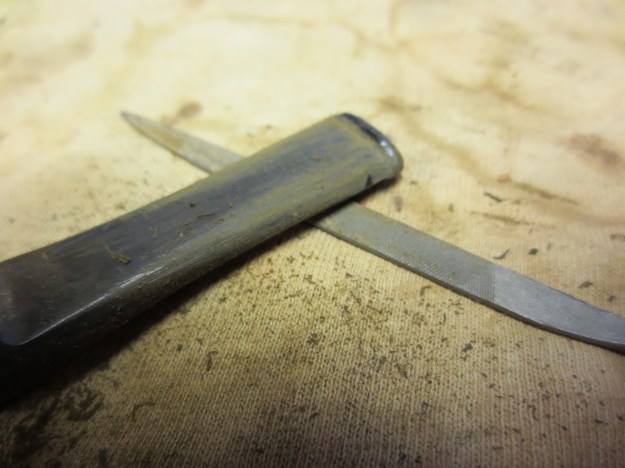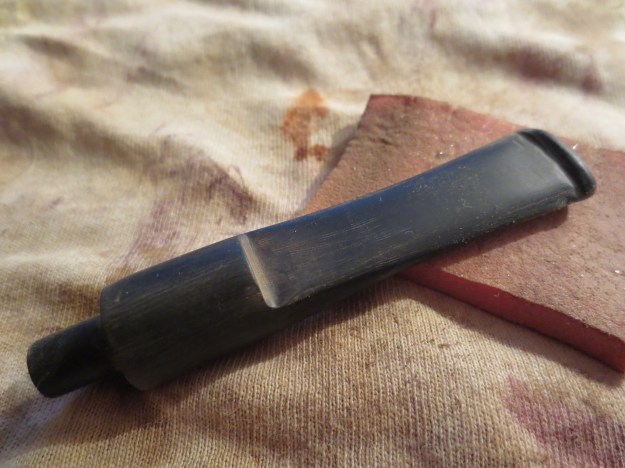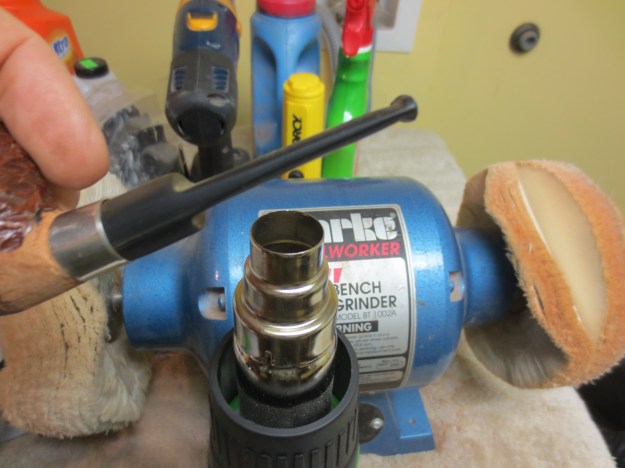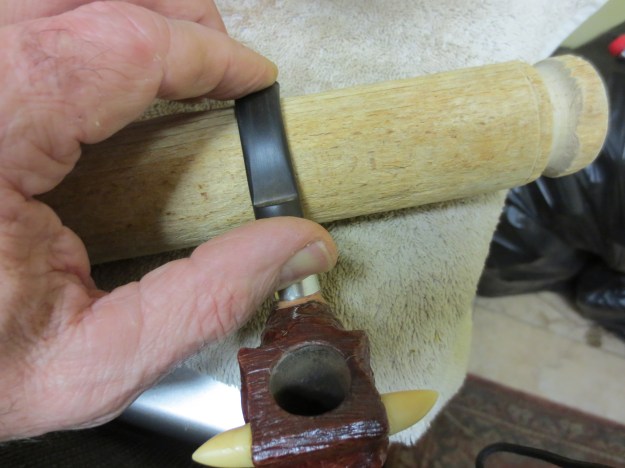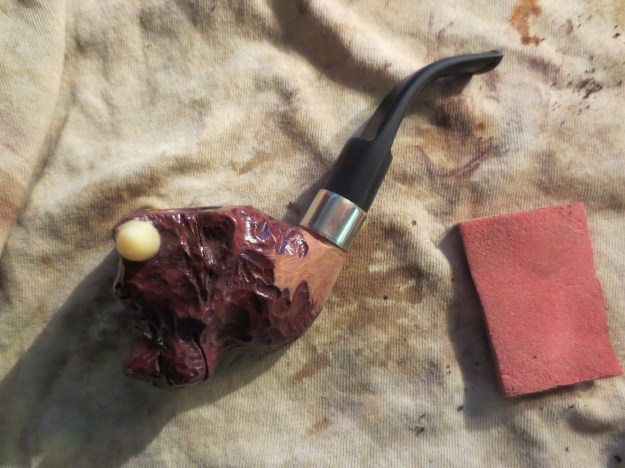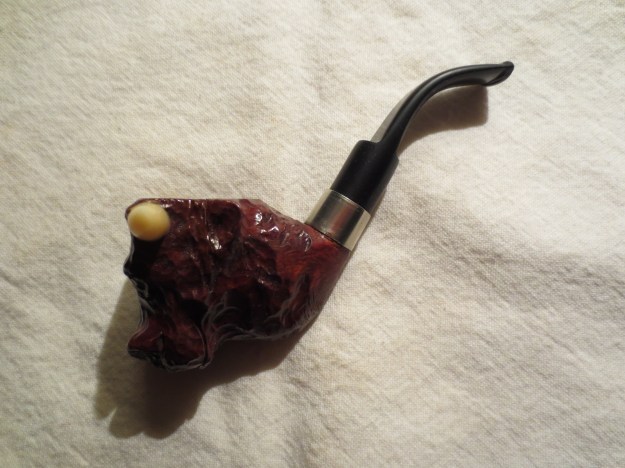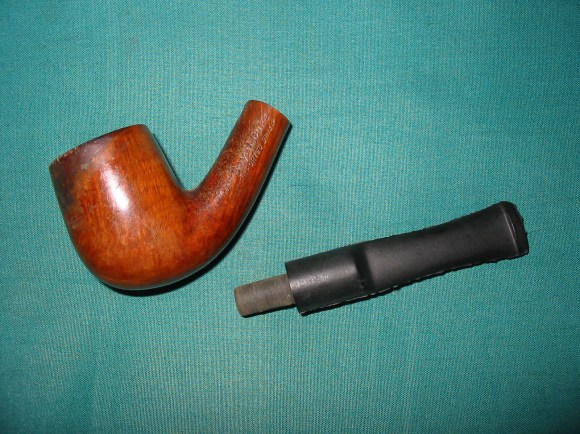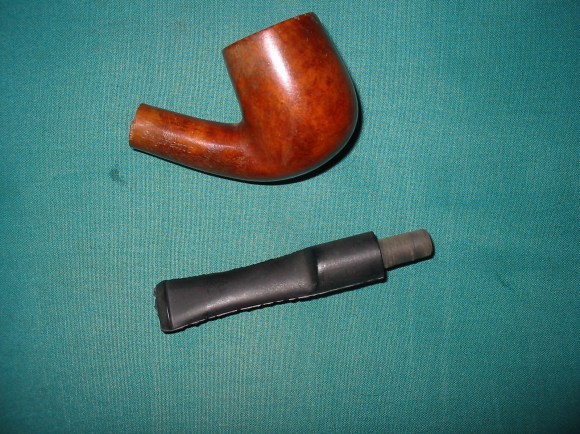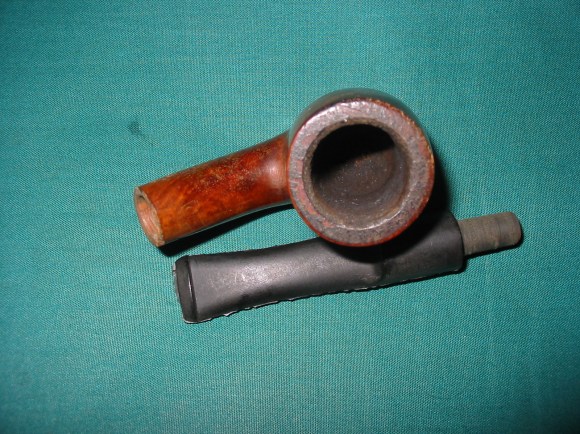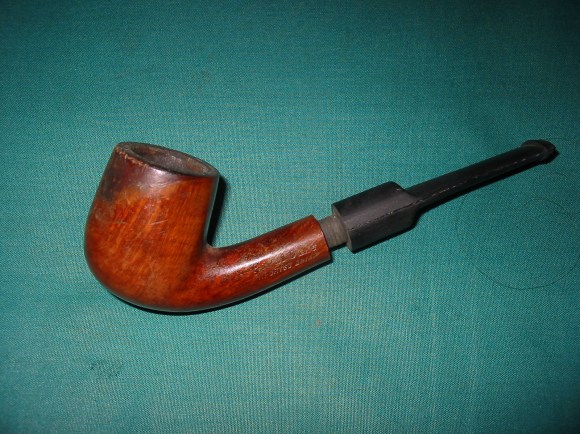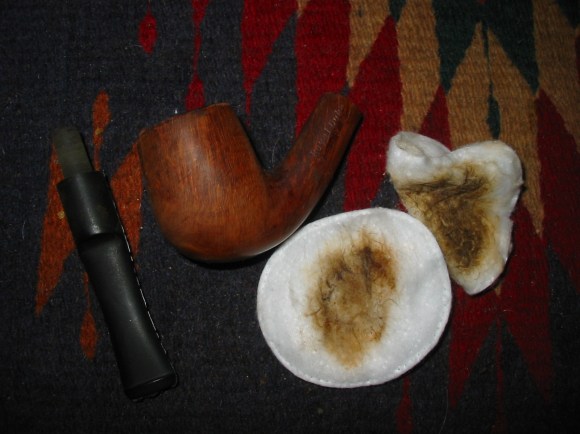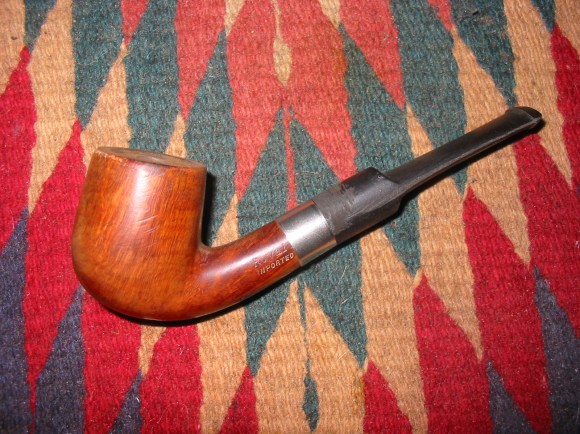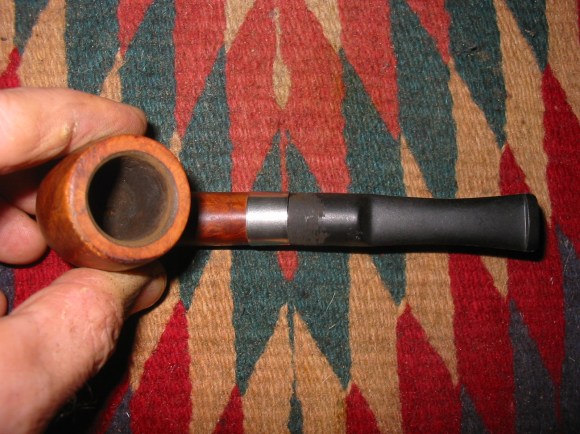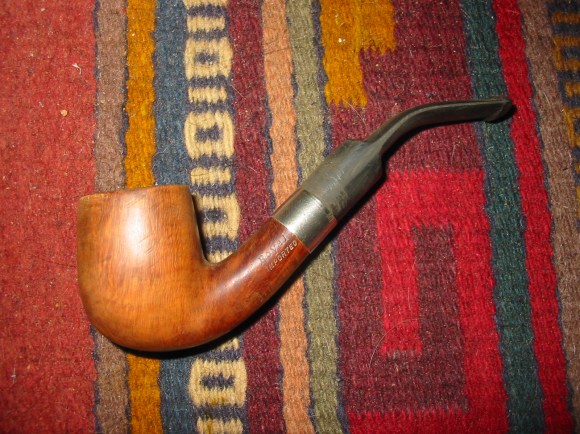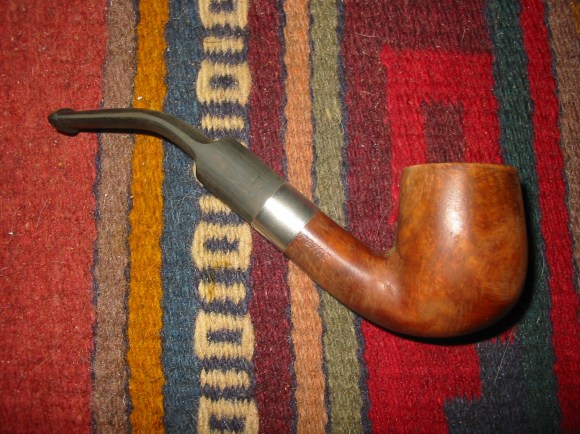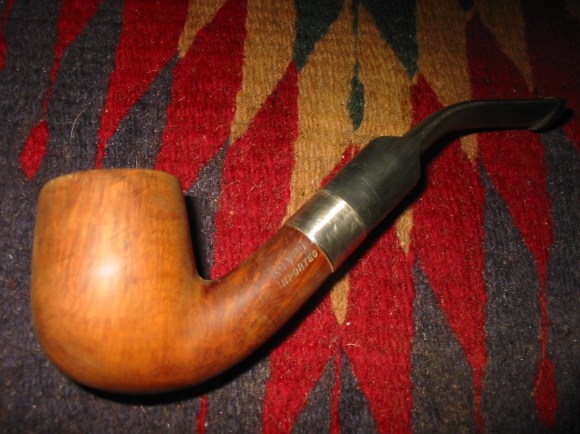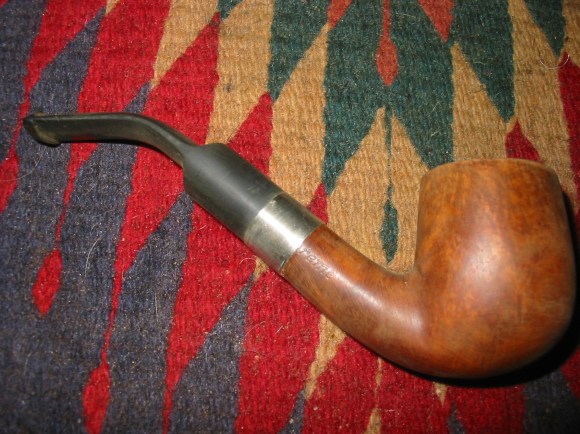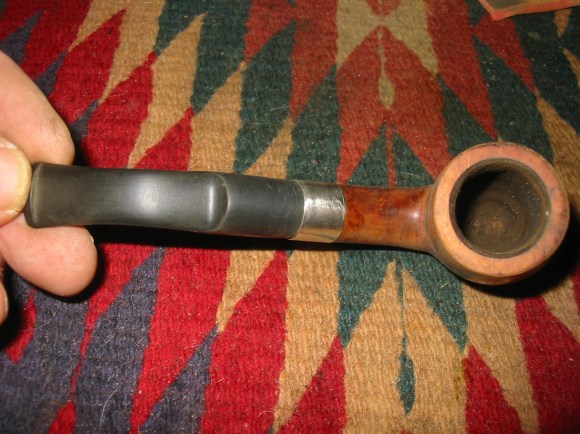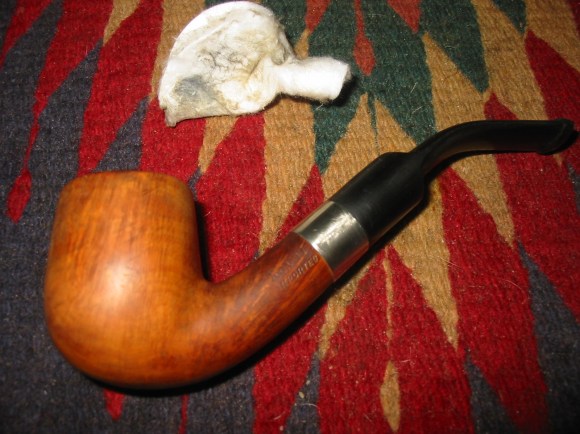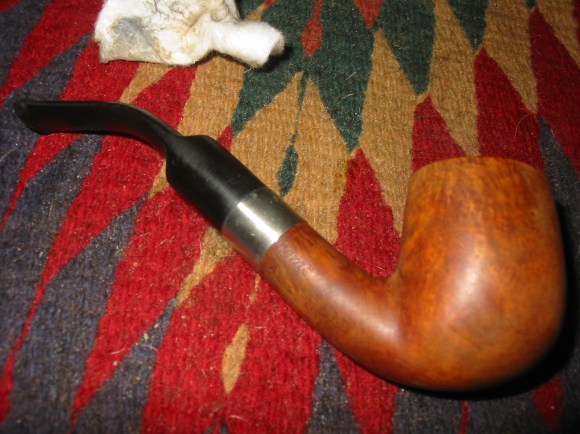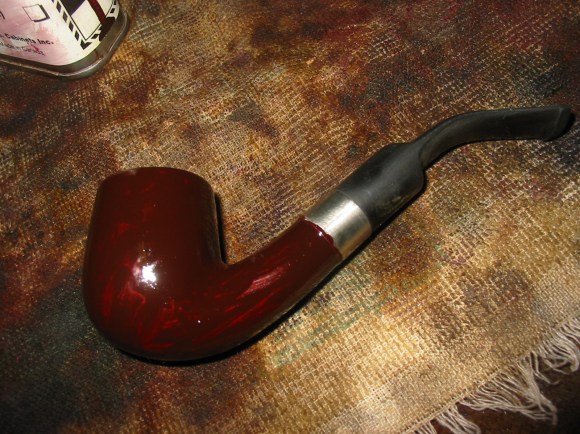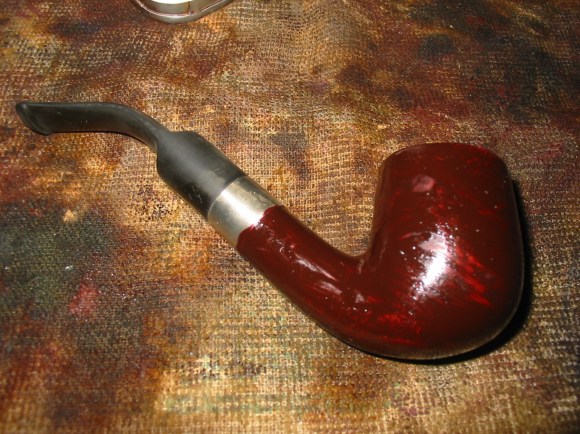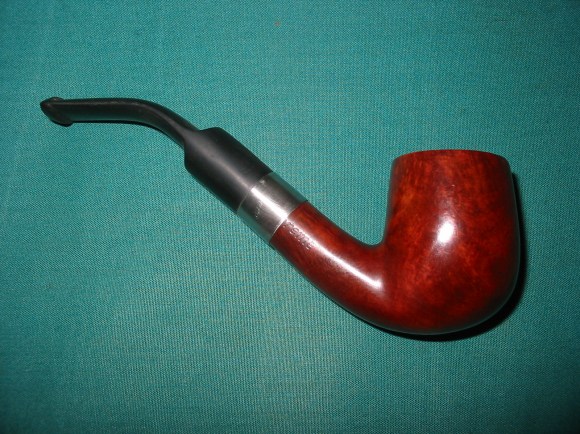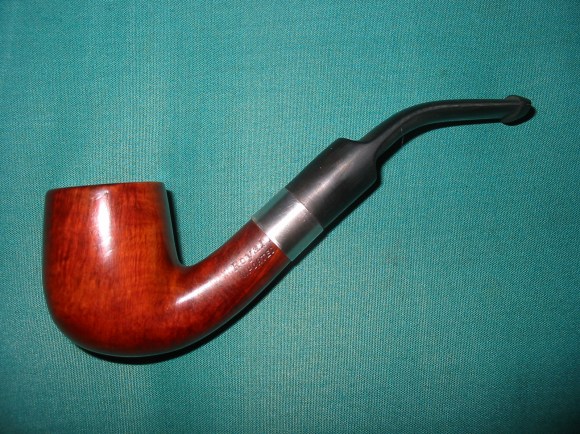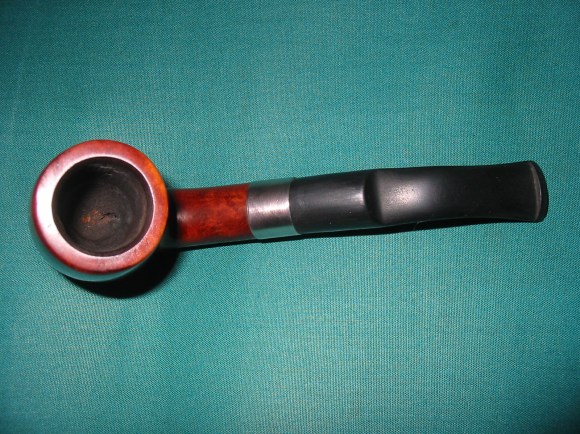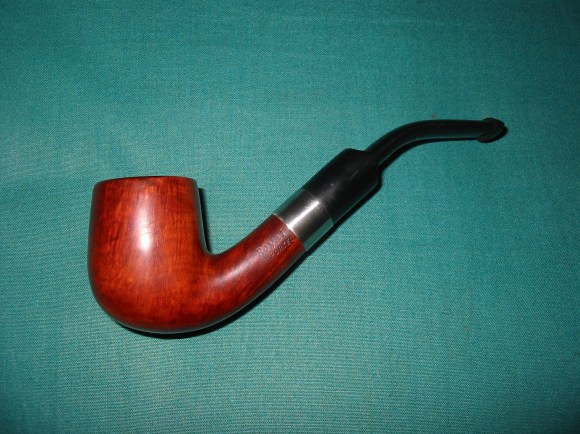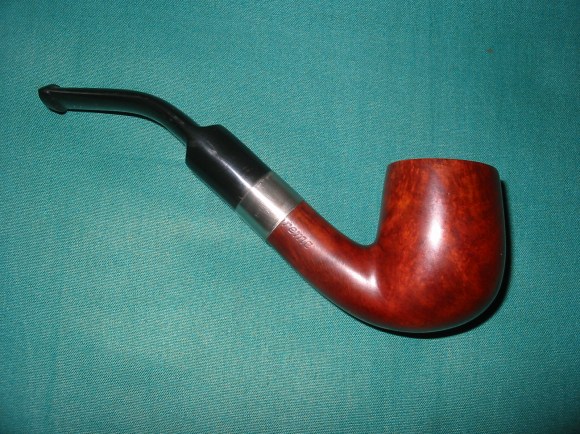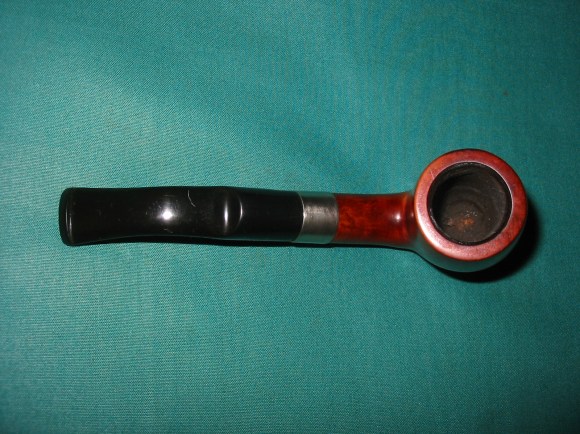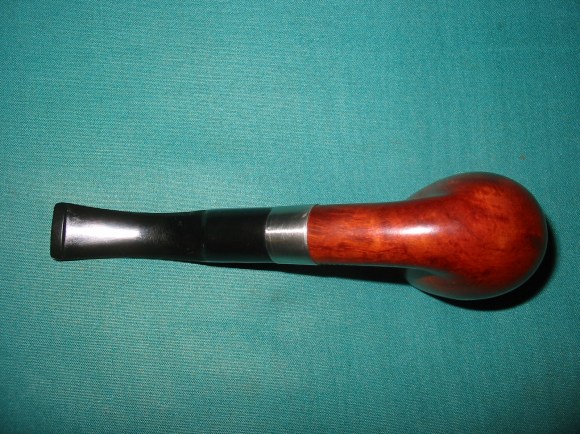Blog by Steve Laug
I thought with this blog that I would take a different tack in the write up and take you through my process of working on each pipe that we purchase. Jeff has set up a spread sheet to track where the pipe came from, the date of purchase and what we paid for it so that we know what we have invested in the pipe before we even work on it. This takes a lot of the guess work out of the process. This particular pipe was purchased on 04/09/2022 from Cleveland, Ohio, USA from a seller we bought quite a few pipes from. I also want you to understand why we take the photos we do. It is not accidental or chance as the photos have been taken to help me make an assessment of the pipe Jeff sees before he starts his clean up work. We do this to record the condition that the pipe was in when received it and to assess what kind of work will need to be done on. When I look at these photos this is what I see.
- The finish is dirty and flat but underneath there is some excellent grain. There are also some leaves carved on the left side of the bowl and around the heel. These were typically done to obscure flaws in the briar.
- The plateau rim top and shank end are dirty. In the rim top plateau there is a lot of lava overflow from the cake in the bowl. Along with that there is dust and debris in both the plateau on the rim top and shank end. Its overall appearance is very dirty looking.
- The bowl has a thick cake in it but the inner edge of the bowl actually looks to be undamaged from what I can see at this point. There does not appear to be any burning or reaming damage to the edges of the bowl. You would be surprised (though maybe not) in how many pipes we pick up that have major issues in this area.
- The stem is vulcanite and has straightened out from heat and sitting and will need to be rebent to match the flow of the shank and bowl.
- The stem had some oxidation and tooth marks and chatter that are visible in the photos below. Nothing to deep but nonetheless present.
Overall my impressions of this pipe is that it is a beauty that once cleaned up will look pretty amazing. The cake does not seem to hide any burns or checking and the exterior of the bowl does not show any hot spots or darkening. When I look it I immediately think of the carver Karl Erik. It has a lot of his stylistic touches that I have come to expect as I have worked on a lot of his pipes over the years. The photos below confirm the assessment above.
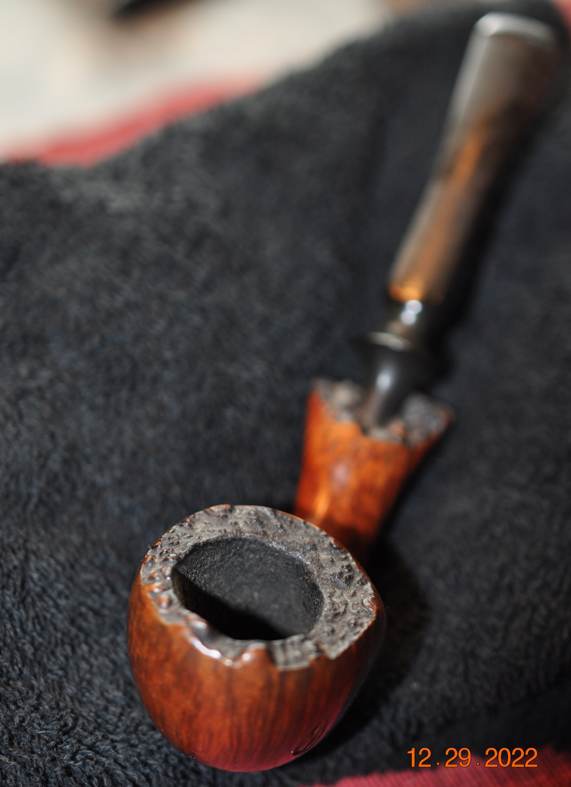 Jeff took close up photos so that I could have a clearer picture of the condition of the bowl and rim edges and top. The rim top photos confirm my assessment above. The cake in the bowl is quite thick and the plateau on the rim top is almost filled in with lava and debris. You can also see the condition of the inner and outer edges of the rim. This is what I look for when assessing a pipe. While there is lava and darkening there is no visible burn damage at this point and the previous reaming has not left damage either. The bowl is still fairly round. The plateau on the shank end is very dusty and dirty as can be seen in the fourth photo below.
Jeff took close up photos so that I could have a clearer picture of the condition of the bowl and rim edges and top. The rim top photos confirm my assessment above. The cake in the bowl is quite thick and the plateau on the rim top is almost filled in with lava and debris. You can also see the condition of the inner and outer edges of the rim. This is what I look for when assessing a pipe. While there is lava and darkening there is no visible burn damage at this point and the previous reaming has not left damage either. The bowl is still fairly round. The plateau on the shank end is very dusty and dirty as can be seen in the fourth photo below.
 His photos of the stem surface confirmed and heightened my assessment of the condition. You can see the oxidation (particularly around the turned area and the speckled surface of the button area) and what appears to be a gummy substance on the stem surface. Note also the tooth marks on the edge of the button on both sides. It is actually more damaged than the surface of the stem.
His photos of the stem surface confirmed and heightened my assessment of the condition. You can see the oxidation (particularly around the turned area and the speckled surface of the button area) and what appears to be a gummy substance on the stem surface. Note also the tooth marks on the edge of the button on both sides. It is actually more damaged than the surface of the stem.
 I always ask Jeff to take photos of the sides and heel of the bowl. While this definitely shows the grain patterns around a bowl it also allows me to do a more thorough assessment of the condition of the briar and the finish. In this case I look at the finish around the carved portions to see if there are any cracks or splits radiating from the pits in the centre of each one. I also look for flaws in the grain as those can also hide cracks or damage. In this case the bowl exterior is sound and should clean up very well. I love the grain patterns and even the odd leaf carvings do not detract too much from that for me.
I always ask Jeff to take photos of the sides and heel of the bowl. While this definitely shows the grain patterns around a bowl it also allows me to do a more thorough assessment of the condition of the briar and the finish. In this case I look at the finish around the carved portions to see if there are any cracks or splits radiating from the pits in the centre of each one. I also look for flaws in the grain as those can also hide cracks or damage. In this case the bowl exterior is sound and should clean up very well. I love the grain patterns and even the odd leaf carvings do not detract too much from that for me. 
 I also ask him to take photos of the stamping so I can see if it is faint in any spots or double stamped or unclear. It often takes several photos to capture what I am looking for. The stamping on the underside of the shank is relatively clear in the picture below. It reads Wenhall [over] Langelinie [over] Freehand [over] Made In Denmark [over] 1. The Wenhall stamp is faint at the top of the stamp but still readable. You can also see that part of the Langelinie is double stamped. The rest of the stamp is clear and readable.
I also ask him to take photos of the stamping so I can see if it is faint in any spots or double stamped or unclear. It often takes several photos to capture what I am looking for. The stamping on the underside of the shank is relatively clear in the picture below. It reads Wenhall [over] Langelinie [over] Freehand [over] Made In Denmark [over] 1. The Wenhall stamp is faint at the top of the stamp but still readable. You can also see that part of the Langelinie is double stamped. The rest of the stamp is clear and readable.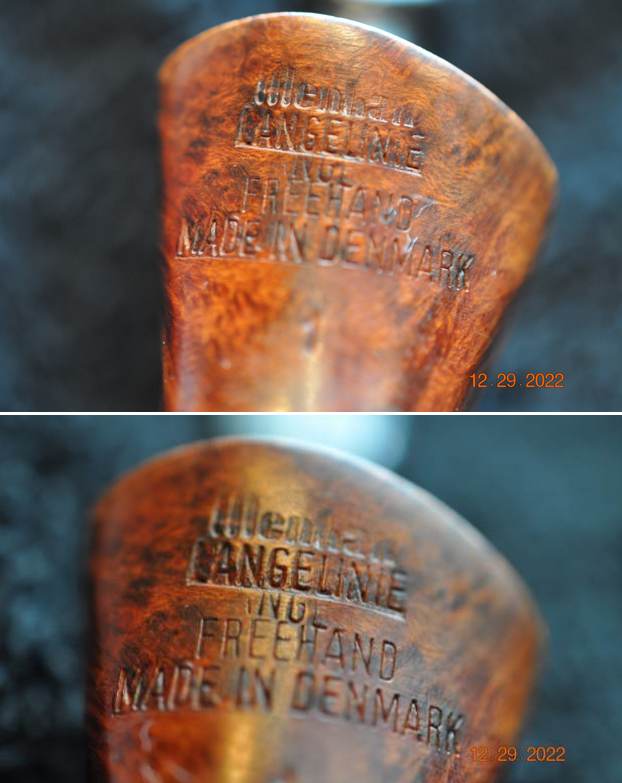 Before I start working on any pipe in my hands I want to confirm its provenance. I want to know for certain who made it rather than just counting on my memory. In this case in the back of my mind I remembered a connection between Wenhall and Karl Erik pipes. I could not remember the details of the connection but I remembered there was one. I have several sites that I turn to for this work. First I turned to Pipephil’s – Pipes, Logos and Stampings website and found that there was no information on the brand there.
Before I start working on any pipe in my hands I want to confirm its provenance. I want to know for certain who made it rather than just counting on my memory. In this case in the back of my mind I remembered a connection between Wenhall and Karl Erik pipes. I could not remember the details of the connection but I remembered there was one. I have several sites that I turn to for this work. First I turned to Pipephil’s – Pipes, Logos and Stampings website and found that there was no information on the brand there.
Then I turned to Pipedia and looked up Wenhall in the Pipe Makers list that is included there. I found the link there I was looking for (https://pipedia.org/wiki/Wenhall). It was a short article but it made a lot of connections to names that I was familiar with from working on pipes. I include the majority of the article because of the pertinent information that it provides and for ease of reference in the future.
Wenhall Pipes Ltd. was a distribution company out of New York City.
By the end of the 1970’s Wenhall approached Michael Kabik and Glen Hedelson, at that time operating from a farm house in Glen Rock, Maryland to create a line of freehands called Wenhall. The situation was favorable, because Kabik & Hedelson had ended their cooperation with Mel Baker of Tobak Ltd. to produce the famed Sven-Lar freehands shortly before.
Upon Wenhall’s offer the partners got a bank loan and set up a studio of 2000 square feet in a fairly new industrial park in Bel Air, Maryland and took on the name Vajra Briar Works. Wenhall initially wanted 500 pipes a week! But Kabik & Hedelson doubted that they could move that much product and told them they would produce 250 pipes per week. Happily, some of the old crew from Sven-Lar joined them at Vajra Briar Works, and thus they rather quickly met the production demands.
Furthermore during this time, Wenhall requested to create a line of pipes consisting of 12 different shapes. The line was called The Presidential and, while they repeated the same 12 shapes for this series, each one was freehand cut. Although they came up with interesting designs, mainly developed by Hedelson, especially Kabik was never really happy with the line or the concept, but, by this time, they had nine people on full-time payroll.
The stint with Wenhall lasted a couple of years, at which time they asked them to join Wenhall in a move to Miami, Florida. But by this time Kabik and Hedelson felt very uncomfortable with the owners of Wenhall and decided that they’d rather close the shop than make the move. Time proved that decision very wise, as Wenhall folded shortly after the move. All the same they had to close Vajra, but scaled down to the two of them and moved the operation to the farm house Glen was currently living in.
Presumably for a shorter period only Wenhall had pipes made in Denmark by Karl Erik. (BTW K.E. Ottendahl ceased all sales to the USA in 1987.)
The last sentence in red above gave me the confirmation I was seeking. I knew that the pipe I had was made in Denmark and thus by Karl Erik. I also knew that it was made before he ceased all sales in the US so that it was made before 1987. That is when his time with Wenhall ended. I always love being able to pin down a time frame for the pipe I am working on and knowing that this one was made prior to 1987 meant this was an older pipe. Now on to the work.
I am sure many of you skip my paragraph on the work Jeff has done before the pipe gets here but it is quite detailed in its brevity. I know some laugh at my opening line Jeff did a thorough cleaning of this pipe. However, I want you to know the details of the work. Back in 2020 Jeff wrote a blog about his cleaning process. I am including a link to that now so you can see what I mean about his process. Do not skip it! Give it a read (https://rebornpipes.com/2020/01/20/got-a-filthy-estate-pipe-that-you-need-to-clean/). Here is the introduction to that blog and it is very true even to this day.
Several have asked about Jeff’s cleaning regimen as I generally summarize it in the blogs that I post rather than give a detailed procedure. I have had the question asked enough that I asked Jeff to put together this blog so that you can get a clear picture of the process he uses. Like everything else in our hobby, people have different methods they swear by. Some may question the method and that is fine. But it works very well for us and has for many years. Some of his steps may surprise you but I know that when I get the pipes from him for my part of the restoration they are impeccably clean and sanitized. I have come to appreciate the thoroughness of the process he has developed because I really like working on clean pipe!
For the benefit of some of you who may be unfamiliar with some of the products he uses I have included photos of three of the items that Jeff mentions in his list. This will make it easier for recognition. These three are definitely North American Products so you will need to find suitable replacements or order these directly on Amazon. The makeup pads are fairly universal as we were able to pick some up in India when we were with Paresh and his family.
In the blog itself he breaks his process down into two parts – cleaning the stem and cleaning the bowl. Each one has a large number of steps that he methodically does every time. I know because I have watched him do the work and I have seen the pipes after his work on them. He followed this process step by step and when the pipe got to me it was spotlessly clean and ready for my work. The inside of the stem, shank and bowl were clean and to me that is an amazing gift as it means that my work on this end is with a clean pipe! I cannot tell you how much difference that makes for my work.
When the pipe arrives here in Vancouver I have a clean pipe and I go over it keeping in mind my assessment shared in the opening paragraph above. I am looking for any significant structural changes in the bowl and finish as I go over it.
- The finish is very clean and the grain stands out on the surface of the clean briar. The carved leaves looked good as well and appeared to have some dark stain tracing the lines in them and helping them stand out. There are no cracks showing up in the grain lines or in the flaws under the leaf carvings. It is sound on the outside. I will need to polish the briar and buff it to bring back the shine.
- The plateau rim top and shank end are clean and have some faded spots due to the cleaning and removing of the tars and oils that were scrubbed off. This will mean that in need to restain them with black and buff them with wax to bring them back to what they looked like when sent to the US originally. The good news for me is that there are no cracks showing up in the rim top plateau or in the shank end plateau. Those two areas are also sound.
- The bowl was very clean and smelled clean. The clean walls did not show evidence of checking or cracking. There were no hot spots or damage on the walls or around the entrance of the airway into the bowl. It was clean and smooth which is great news for me. The inner edge of the bowl was undamaged and did not show any sign of burning or reaming damage to the edges of the bowl. Both the shank and the bowl were very clean showing no debris on a clean pipe clean run through them. I would need to give it a final cleaning with pipe cleaners and alcohol once I had finished with the external work to remove the debris that may have collected there in the process.
- The vulcanite stem has clearly straightened over the years and that can be seen in the angle of the stem to the top of the bowl. I will need to heat it and bend the end to match the angle of the rim top. I always aim to get a basic straight line from the rim top to the curve of the stem when it is sitting in my mouth.
- The oxidation was gone from the stem after Jeff’s work on it. The tooth marks and chatter will need to be dealt with once I finish the bowl.
Hopefully the steps above show you both what I look for when I go over the pipe when I bring it to the work table and also what I see when I look at the pipe in my hands. They also clearly spell out a restoration plan in short form. My work is clear and addressing it will be the next steps. I took photos of the whole pipe to give you a picture of what I see when I have it on the table. This is important to me in that it also shows that there was no damage done during the clean up work or the transit of the pipe from Idaho to here in Vancouver.
 I then spend some time going over the bowl and rim top to get a sense of what is happening there. Remember that with plateau tops there can be dips in the plateau that extend into the bowl edge and are not damage but rather a natural feature. You can see the fading to the black of the plateau on the bowl top and the shank end. It is clean but will need to be restained to match what it was when made. I also went over the stem carefully. There were dents in the stem that are visible in the photos. But the good news is that the tooth marks were not deep and did not seem to puncture the airway. They would clean up well. I examined the button edge as it was damaged with tooth marks as well but I was happy to see that there were no cracks in the button surface. I took photos of the rim top and stem sides to show as best as I can what I see when I look at them.
I then spend some time going over the bowl and rim top to get a sense of what is happening there. Remember that with plateau tops there can be dips in the plateau that extend into the bowl edge and are not damage but rather a natural feature. You can see the fading to the black of the plateau on the bowl top and the shank end. It is clean but will need to be restained to match what it was when made. I also went over the stem carefully. There were dents in the stem that are visible in the photos. But the good news is that the tooth marks were not deep and did not seem to puncture the airway. They would clean up well. I examined the button edge as it was damaged with tooth marks as well but I was happy to see that there were no cracks in the button surface. I took photos of the rim top and stem sides to show as best as I can what I see when I look at them. I always check to make sure that the clean up work did not damage the stamping on the shank in any way. I know Jeff is cognizant of this but I do it anyway and take a photo to show what I see when I examine it. In this case it has not changed at all from the pictures I included above. I also remove the stem from the shank and check the tenon and lay the parts of the pipe out to get a sense of the proportion that was in the mind of the pipe maker when he crafted the pipe. It is a beauty in flow and shape.
I always check to make sure that the clean up work did not damage the stamping on the shank in any way. I know Jeff is cognizant of this but I do it anyway and take a photo to show what I see when I examine it. In this case it has not changed at all from the pictures I included above. I also remove the stem from the shank and check the tenon and lay the parts of the pipe out to get a sense of the proportion that was in the mind of the pipe maker when he crafted the pipe. It is a beauty in flow and shape.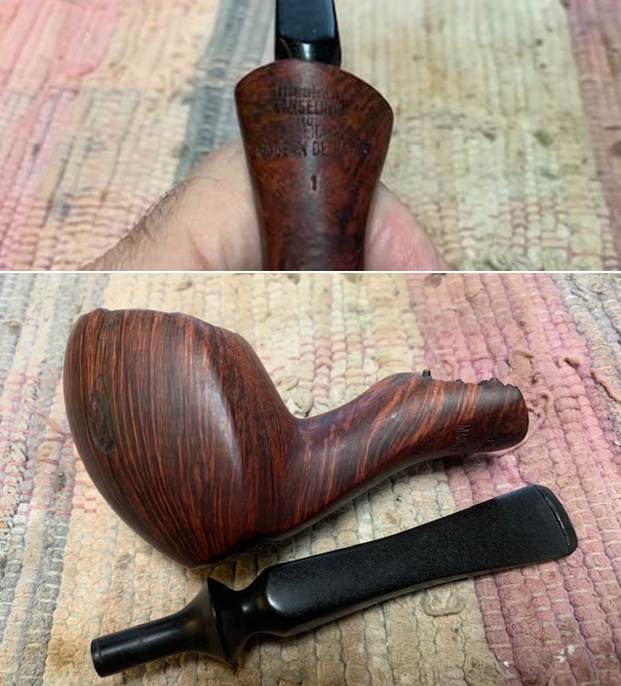 The question at this point of where to begin the restoration work is always a matter of personal preference. If you read this blog much you will see that each of the restorers who post here all start at different points. I personally almost always start with the bowl because I truly do not like the tedious work of stem repairs and polishing. I always leave that until last even though I know that it needs to be done. So if you are restoring your pipes choose where you want to start and go from there. Just know that it all will need to be done by the end but for me the encouragement of seeing a rejuvenated bowl is the impetus I need to attack the stem work.
The question at this point of where to begin the restoration work is always a matter of personal preference. If you read this blog much you will see that each of the restorers who post here all start at different points. I personally almost always start with the bowl because I truly do not like the tedious work of stem repairs and polishing. I always leave that until last even though I know that it needs to be done. So if you are restoring your pipes choose where you want to start and go from there. Just know that it all will need to be done by the end but for me the encouragement of seeing a rejuvenated bowl is the impetus I need to attack the stem work.
For me then I started working on this pipe by turning to the bowl. I chose to deal with the faded plateau on the rim and shank first because I would be polishing the briar and always like to go over the rim top and shank end plateau at the same time. I find that polishing those areas with micromesh differentiates the high points of the plateau from the valleys. I used a black stain pen to restain both areas. Remember this is only the first step in rim top staining. Polishing the briar will come next and that will change these areas as well. From here I turned to polishing the briar with micromesh sanding pads. I choose to dry sand the briar rather than wet sand it. Again it is a matter of personal preference. I prefer to use the pads dry and find they work very well on the briar. I sand with each pad (9 in total) and group them by threes for ease of reference. I also work over the plateau areas at the same time. I wipe the bowl down after each pad with a damp cloth to remove the sanding debris and check the briar. I love seeing the developing shine on the briar as I move through the pads which is why I include so many photos of this step. Pay attention to the changes in the briar and the plateau top in these photos as you work through them.
From here I turned to polishing the briar with micromesh sanding pads. I choose to dry sand the briar rather than wet sand it. Again it is a matter of personal preference. I prefer to use the pads dry and find they work very well on the briar. I sand with each pad (9 in total) and group them by threes for ease of reference. I also work over the plateau areas at the same time. I wipe the bowl down after each pad with a damp cloth to remove the sanding debris and check the briar. I love seeing the developing shine on the briar as I move through the pads which is why I include so many photos of this step. Pay attention to the changes in the briar and the plateau top in these photos as you work through them.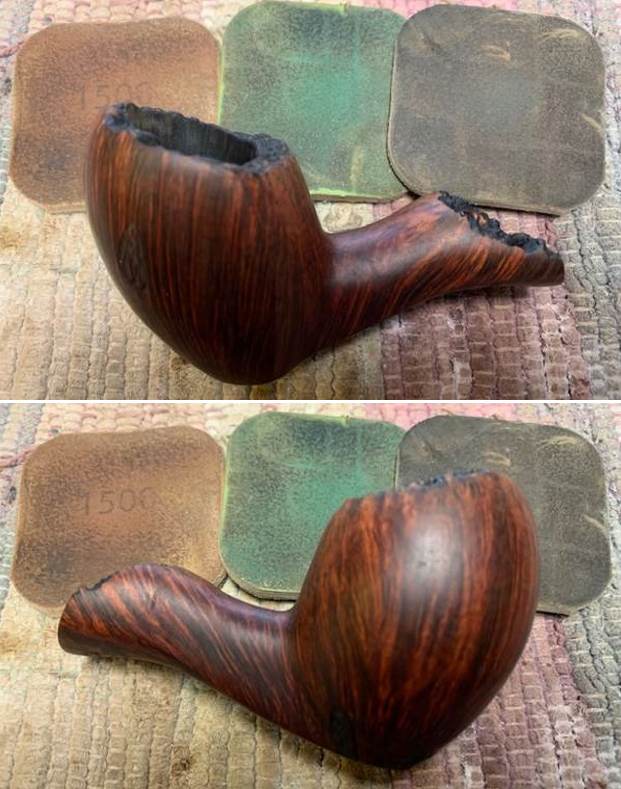





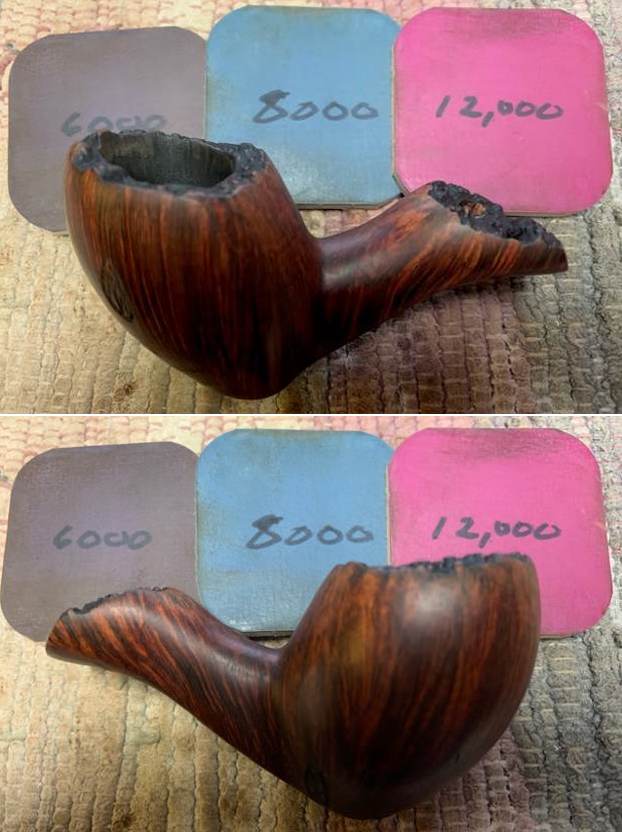

 To further sharpen the curves and grooves of the plateau on the shank and rim top I used a brass bristle wire brush. It is soft enough metal to clean up edges but not hard enough to scratch the surface of the briar.
To further sharpen the curves and grooves of the plateau on the shank and rim top I used a brass bristle wire brush. It is soft enough metal to clean up edges but not hard enough to scratch the surface of the briar. For the past few years now I have been using a product developed by Mark Hoover called Before & After Restoration Balm. I find that it is remarkable in its ability to really give the bowl deepened sense of colour and grain. It is a paste/balm that is rubbed into the surface of the briar and the plateau. The product works to deep clean the nooks and crannies of finish, enliven and protect the briar. I worked it into the briar with my finger tips and a horsehair shoe brush to get it into the grooves of the plateau. I let it sit for 10 minutes to let it do its work. I wiped it off with a soft cloth then buffed it with a cotton cloth. The briar and the plateau really began to have a deep shine in the briar. The photos I took of the bowl at this point mark the progress in the restoration. You see the shine that the briar has taken on and the contrast finish on the plateau areas is very beautiful. It is a gorgeous pipe.
For the past few years now I have been using a product developed by Mark Hoover called Before & After Restoration Balm. I find that it is remarkable in its ability to really give the bowl deepened sense of colour and grain. It is a paste/balm that is rubbed into the surface of the briar and the plateau. The product works to deep clean the nooks and crannies of finish, enliven and protect the briar. I worked it into the briar with my finger tips and a horsehair shoe brush to get it into the grooves of the plateau. I let it sit for 10 minutes to let it do its work. I wiped it off with a soft cloth then buffed it with a cotton cloth. The briar and the plateau really began to have a deep shine in the briar. The photos I took of the bowl at this point mark the progress in the restoration. You see the shine that the briar has taken on and the contrast finish on the plateau areas is very beautiful. It is a gorgeous pipe.

 Now it was time to address the part of the restoration I leave until last. I set the bowl aside and turned my attention to the stem. I wanted to repair the tooth damage on the stem surface and on the surface of the button. Before doing any repairs to a stem surface I try to lift the marks as much as possible. To do that I use a Bic lighter to heat the tooth marks and dents in the stem surface. I describe that as “painting” the surface. What I mean by that is that I hold the stem stationary and quickly move the flame of the lighter across the dents repeatedly. Typically I am able to lift the dents significantly and sometimes in totality with the heat. It utilizes the “memory” vulcanite and the heat raises the marks.
Now it was time to address the part of the restoration I leave until last. I set the bowl aside and turned my attention to the stem. I wanted to repair the tooth damage on the stem surface and on the surface of the button. Before doing any repairs to a stem surface I try to lift the marks as much as possible. To do that I use a Bic lighter to heat the tooth marks and dents in the stem surface. I describe that as “painting” the surface. What I mean by that is that I hold the stem stationary and quickly move the flame of the lighter across the dents repeatedly. Typically I am able to lift the dents significantly and sometimes in totality with the heat. It utilizes the “memory” vulcanite and the heat raises the marks. In this case I lifted all but two – one on each side. The heat did not have any effect on the tooth damage on the edge of the button. To take care of that I filled the edge in with clear CA glue and let it cure. Once it was hardened I recut the button edge with a small file to clean up the damage.
In this case I lifted all but two – one on each side. The heat did not have any effect on the tooth damage on the edge of the button. To take care of that I filled the edge in with clear CA glue and let it cure. Once it was hardened I recut the button edge with a small file to clean up the damage.
 I finished the reworking of the button and stem with 220 grit sandpaper and started polishing it with 600 grit wet dry sandpaper to remove the scratches. This process makes the repairs almost invisible when polished and also takes care of scratching in the surface of the vulcanite.
I finished the reworking of the button and stem with 220 grit sandpaper and started polishing it with 600 grit wet dry sandpaper to remove the scratches. This process makes the repairs almost invisible when polished and also takes care of scratching in the surface of the vulcanite.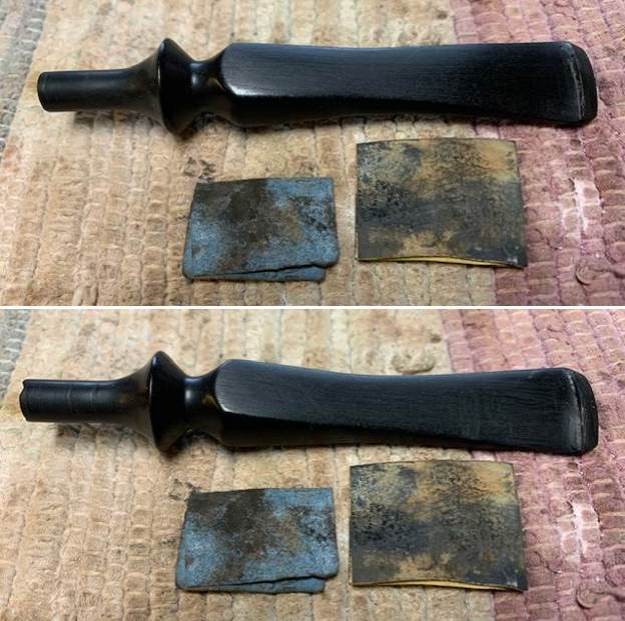 I usually heat a stem to be bent with my heat gun until it is pliable then set it with running water. Today however I ran into a problem. My heat gun is no where to be found. I evidently either loaned to someone who still has it or it is somewhere in the house where I have overlooked it in the hunt. So I had to resort to an older way of heating the stem that is a bit more tricky. I “painted” the underside of the stem at the bend that was present with the flame of a Bic lighter as described above. When it became soft and pliable enough to bend to the angle I wanted I set the bend with cold water and dried it off. I checked the angle of the bend with the shank repeatedly until I was happy with the new look. I took some photos of the stem and of the stem in place in the shank and have included them below. It is possible to bend a stem with minimal tools.
I usually heat a stem to be bent with my heat gun until it is pliable then set it with running water. Today however I ran into a problem. My heat gun is no where to be found. I evidently either loaned to someone who still has it or it is somewhere in the house where I have overlooked it in the hunt. So I had to resort to an older way of heating the stem that is a bit more tricky. I “painted” the underside of the stem at the bend that was present with the flame of a Bic lighter as described above. When it became soft and pliable enough to bend to the angle I wanted I set the bend with cold water and dried it off. I checked the angle of the bend with the shank repeatedly until I was happy with the new look. I took some photos of the stem and of the stem in place in the shank and have included them below. It is possible to bend a stem with minimal tools.
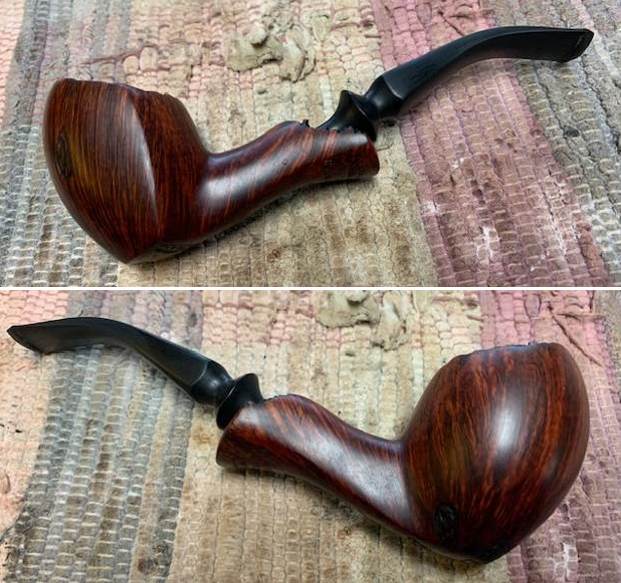
 With the bend in the stem finished I needed to polish the stem and bring back a shine. I use micromesh sanding pads and water to wet sand the stem with 1500-12000 grit sanding pads. I wiped it down after each sanding pad with Obsidian Oil on a cotton rag after each sanding pad as I find it does two things – first it protects the vulcanite and second it give the sanding pads bite in the polishing process.
With the bend in the stem finished I needed to polish the stem and bring back a shine. I use micromesh sanding pads and water to wet sand the stem with 1500-12000 grit sanding pads. I wiped it down after each sanding pad with Obsidian Oil on a cotton rag after each sanding pad as I find it does two things – first it protects the vulcanite and second it give the sanding pads bite in the polishing process.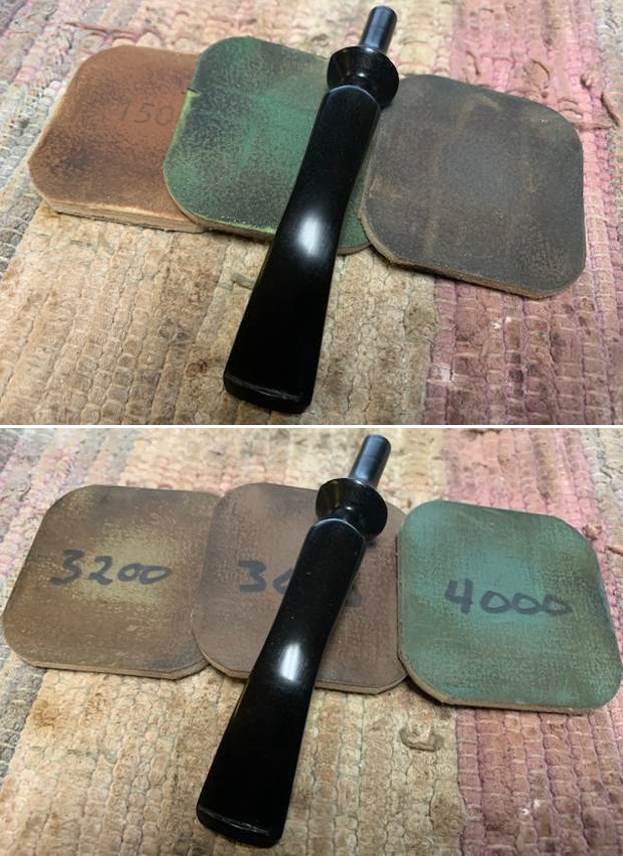
 After finishing with the micromesh pads I rub the stem down with Before & After Fine and Extra Fine stem polish as it seems to really remove the fine scratches in the vulcanite. I rub the Fine Polish on the stem and wipe it off with a paper towel and then repeat the process with the extra fine polish. I finish the polishing of the stem down with a final coat of Obsidian Oil and set the stem aside to let the oil absorb. This process gives the stem a shine and also a bit of protection from oxidizing quickly.
After finishing with the micromesh pads I rub the stem down with Before & After Fine and Extra Fine stem polish as it seems to really remove the fine scratches in the vulcanite. I rub the Fine Polish on the stem and wipe it off with a paper towel and then repeat the process with the extra fine polish. I finish the polishing of the stem down with a final coat of Obsidian Oil and set the stem aside to let the oil absorb. This process gives the stem a shine and also a bit of protection from oxidizing quickly. The final steps in my process involve using the buffer. I first buff the stem and the briar with Blue Diamond on the buffing wheel. Blue Diamond is a plastic polish but I find that it works very well to polish out the light scratches in the vulcanite and the briar. I work the pipe over on the wheel with my finger or thumb in the bowl to keep it from becoming airborne. It works well and I am able to carefully move forward with the buffing. I lightly buff the plateau on the rim top and shank end at the same time making sure to keep the product from building up in the grooves of the finish.
The final steps in my process involve using the buffer. I first buff the stem and the briar with Blue Diamond on the buffing wheel. Blue Diamond is a plastic polish but I find that it works very well to polish out the light scratches in the vulcanite and the briar. I work the pipe over on the wheel with my finger or thumb in the bowl to keep it from becoming airborne. It works well and I am able to carefully move forward with the buffing. I lightly buff the plateau on the rim top and shank end at the same time making sure to keep the product from building up in the grooves of the finish. 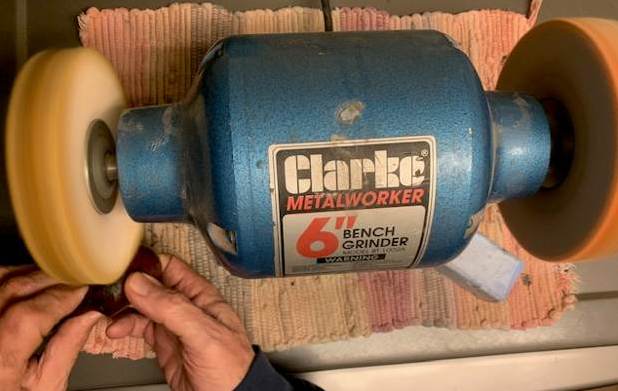
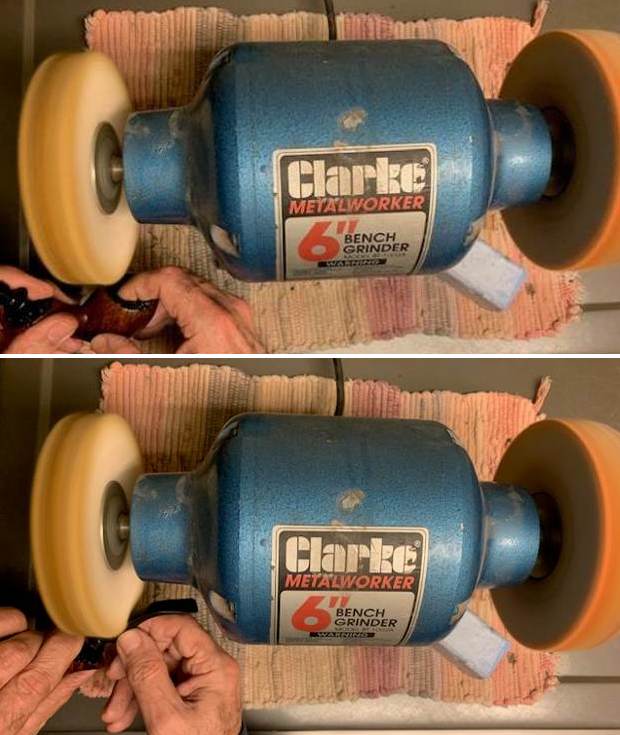 I finished with the Blue Diamond and moved on to buffing with carnauba wax. Once I have a good shine in the briar and vulcanite I always give the bowl and the stem multiple coats of carnauba wax. I have found that I can get a deeper shine if I following up the wax buff with a clean buffing pad. It works to raise the shine and then I follow that up with a hand buff with a microfiber cloth to deepen the shine. It is always fun for me to see what the polished bowl looks like with the polished vulcanite stem. It really is a beautiful pipe. The smooth finish around the bowl sides and shank show the grain shining through the rich brown stains of this Karl Erik Wenhall Langelinie Freehand. The black plateau on the shank end and rim top looked very good with some of the high points showing through in brown. The contrast in the combination looks very good. The finished pipe feels great in my hand. It is light and well balanced. Have a look at it with the photos below. The dimensions are Length: 6 inches, Height: 2 ½ inches, Outside diameter of the bowl: 1 ½ inches, Chamber diameter: 7/8 of an inch. The weight of the pipe is 1.90 ounces/54 grams. It is a beautiful pipe and one that I will be putting on the rebornpipes store in the Danish Pipe Maker section.
I finished with the Blue Diamond and moved on to buffing with carnauba wax. Once I have a good shine in the briar and vulcanite I always give the bowl and the stem multiple coats of carnauba wax. I have found that I can get a deeper shine if I following up the wax buff with a clean buffing pad. It works to raise the shine and then I follow that up with a hand buff with a microfiber cloth to deepen the shine. It is always fun for me to see what the polished bowl looks like with the polished vulcanite stem. It really is a beautiful pipe. The smooth finish around the bowl sides and shank show the grain shining through the rich brown stains of this Karl Erik Wenhall Langelinie Freehand. The black plateau on the shank end and rim top looked very good with some of the high points showing through in brown. The contrast in the combination looks very good. The finished pipe feels great in my hand. It is light and well balanced. Have a look at it with the photos below. The dimensions are Length: 6 inches, Height: 2 ½ inches, Outside diameter of the bowl: 1 ½ inches, Chamber diameter: 7/8 of an inch. The weight of the pipe is 1.90 ounces/54 grams. It is a beautiful pipe and one that I will be putting on the rebornpipes store in the Danish Pipe Maker section.
Hopefully this tack of writing this blog is helpful to you in some way. In it I show both what I am looking for and how I move forward in addressing what I see when work on a pipe has been helpful to you. It is probably the most straightforward detailed description of my work process. As always I encourage your questions and comments as you read the blog. Thanks to each of you who are reading this blog. Remember we are not pipe owners; we are pipemen and women who hold our pipes in trust until they pass on into the trust of those who follow us.






